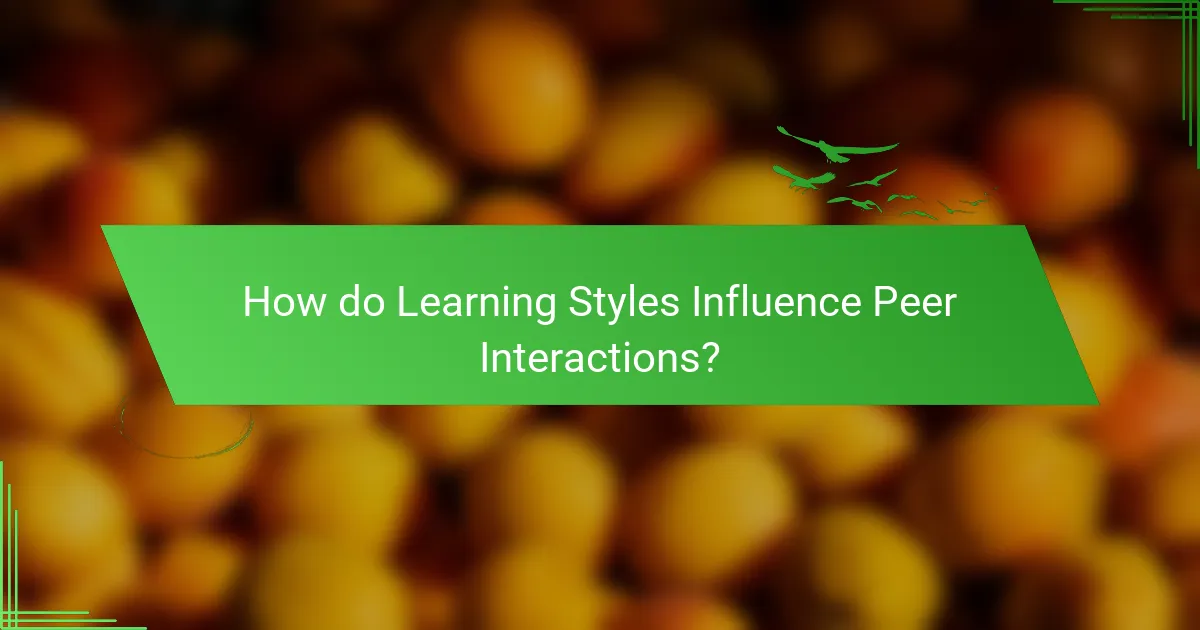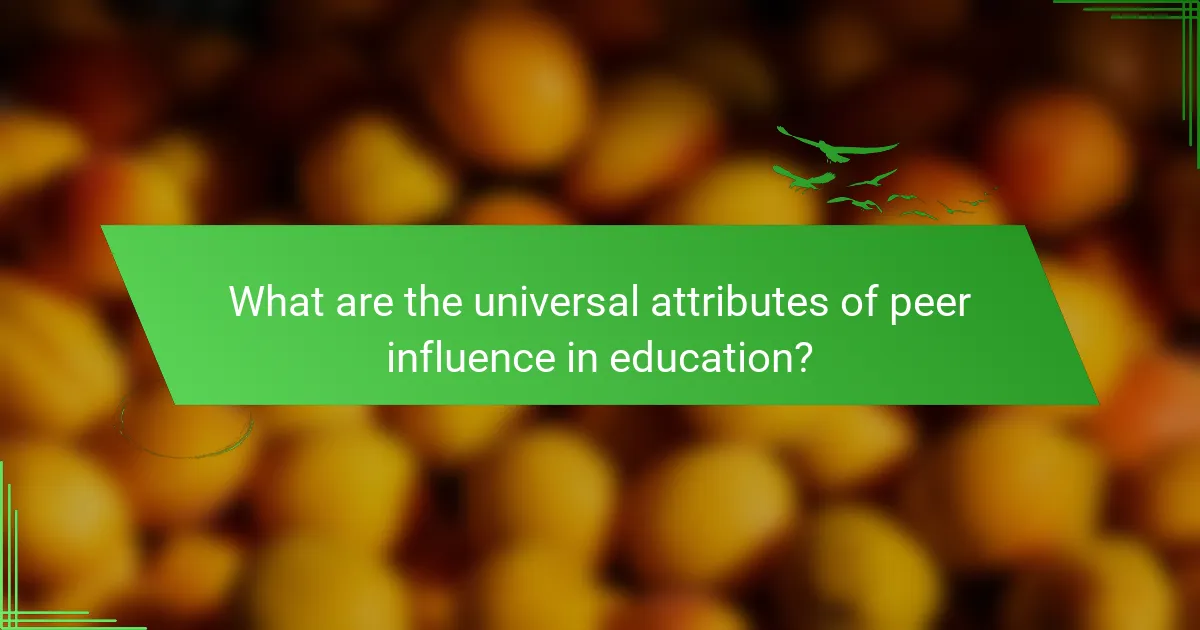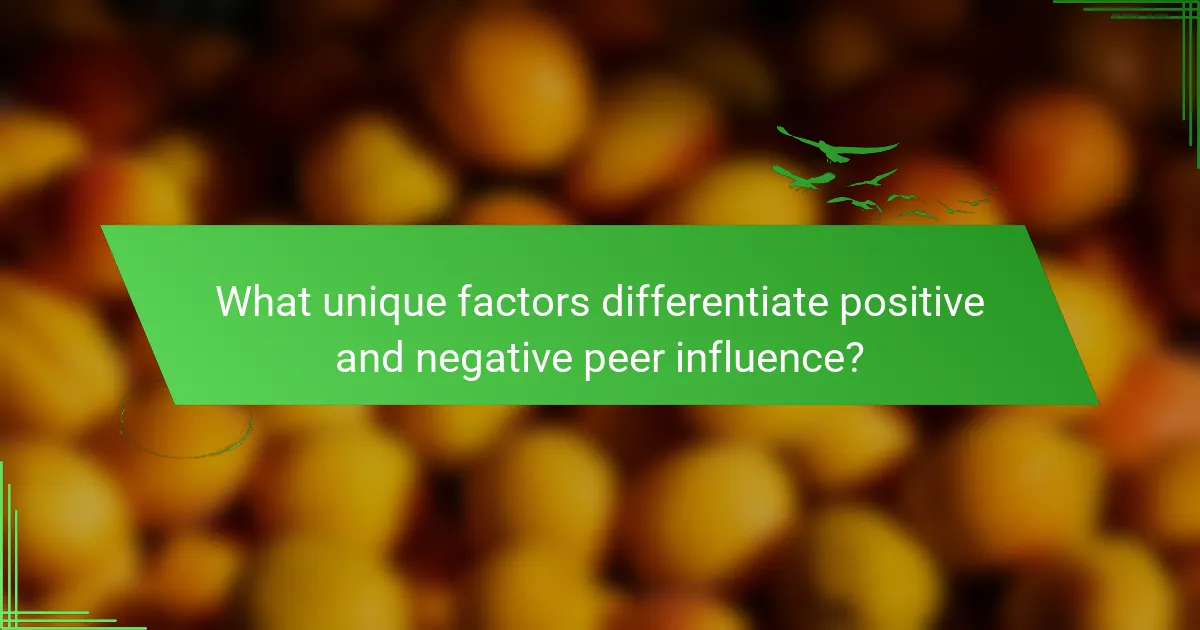Understanding how learning styles and peer influence shape student behaviour is crucial for educators. Learning styles impact communication and collaboration, leading to diverse group dynamics. Peer influence affects attitudes and academic performance, with both positive and negative outcomes. Recognising factors like cultural background and emotional intelligence can enhance educational strategies and support a constructive classroom environment.

How do Learning Styles Influence Peer Interactions?
Learning styles significantly impact peer interactions by shaping communication preferences and collaboration dynamics. For instance, visual learners may prefer graphic organisers, while auditory learners thrive in discussions. This diversity can lead to misunderstandings or enhanced creativity, depending on how well peers adapt to each other’s styles. Recognising these differences fosters a collaborative environment that respects unique attributes, ultimately improving group outcomes.
What are the main types of learning styles?
The main types of learning styles are visual, auditory, and kinesthetic. Visual learners benefit from diagrams and charts, auditory learners thrive on lectures and discussions, while kinesthetic learners excel through hands-on activities. Understanding these styles helps educators tailor instruction, enhancing peer influence and collaborative learning.
How do peers impact individual learning styles?
Peers significantly influence individual learning styles by shaping attitudes, behaviours, and engagement in educational settings. Positive peer interactions can enhance motivation and collaborative learning, while negative influences may lead to disengagement and hinder personal growth. Research shows that peer acceptance and support are crucial for adopting effective learning strategies. As a result, educators must foster a positive peer environment to optimise learning outcomes.
What role does group dynamics play in learning?
Group dynamics significantly influence learning by shaping student engagement and motivation. Positive peer interactions enhance collaborative learning, while negative influences can hinder moral development. Research shows that students in supportive groups demonstrate higher academic achievement and retention rates. Understanding these dynamics helps educators foster better learning environments.
What are the psychological effects of peer influence on learning?
Peer influence can significantly impact learning by shaping attitudes, motivation, and academic performance. Negative peer pressure often leads to lower engagement and poor study habits, while positive peer interactions can enhance collaborative learning and motivation. Research indicates that students in supportive peer groups tend to achieve higher academic success due to shared goals and accountability. Thus, understanding the psychological effects of peer influence is crucial for fostering effective learning environments.

What are the universal attributes of peer influence in education?
Peer influence in education universally shapes behaviour, attitudes, and academic performance. Key attributes include social norms, emotional support, and group dynamics. Social norms dictate acceptable behaviours, impacting students’ choices. Emotional support fosters a sense of belonging, enhancing motivation. Group dynamics influence collaboration and competition, affecting learning outcomes. Understanding these attributes helps educators leverage peer influence positively.
How does social conformity affect academic performance?
Social conformity can negatively impact academic performance by encouraging peer pressure and distracting behaviours. Students may prioritise fitting in over studying, leading to lower grades. Research indicates that individuals in groups often adopt attitudes and behaviours that align with their peers, which can diminish motivation and focus on academic tasks. In environments where conformity is strong, unique learning styles may be suppressed, limiting individual academic potential.
What is the relationship between peer support and motivation?
Peer support significantly enhances motivation in educational settings. When students engage with supportive peers, they experience increased encouragement and accountability, which fosters a positive learning environment. This dynamic can lead to improved academic performance and greater persistence in challenging tasks. Additionally, peer influence can shape learning styles, promoting collaborative strategies that align with individual strengths. As a result, students often feel more motivated to participate actively in their education.

What unique factors differentiate positive and negative peer influence?
Positive peer influence encourages constructive behaviours, while negative peer influence promotes harmful actions. Positive influence often fosters collaboration, motivation, and academic success, whereas negative influence can lead to risky behaviours, decreased self-esteem, and poor academic performance. The unique attribute of peer influence lies in its ability to shape individual learning styles and moral development. Understanding these factors is crucial for educators aiming to create supportive learning environments.
What are the characteristics of constructive peer relationships?
Constructive peer relationships are characterised by mutual respect, open communication, shared goals, and positive reinforcement. These relationships enhance learning by fostering collaboration and support. They encourage students to express themselves freely, leading to improved academic performance and social skills. A unique attribute of constructive peer relationships is their ability to promote resilience among students, helping them navigate challenges together.
How can negative peer influence manifest in educational settings?
Negative peer influence in educational settings manifests through behaviours such as bullying, substance abuse, and academic dishonesty. These influences can lead to decreased motivation, lower academic performance, and increased dropout rates. For example, students may engage in cheating due to pressure from peers, undermining their learning integrity. Additionally, negative social dynamics can create environments where positive behaviours are discouraged, further perpetuating a cycle of poor choices and attitudes toward education.
What are the signs of detrimental peer pressure?
Signs of detrimental peer pressure include changes in behaviour, declining academic performance, and increased risk-taking. Individuals may exhibit anxiety or withdrawal when pressured to conform. Additionally, they may adopt negative attitudes or engage in substance use. Recognising these signs is crucial for intervention and support in educational settings.

What rare attributes can affect learning styles and peer influence?
Peer influence can significantly affect learning styles through rare attributes like cultural background, emotional intelligence, and social capital. Cultural background shapes perspectives and approaches to learning, influencing how peers interact and support each other. Emotional intelligence impacts the ability to empathise and collaborate, affecting peer dynamics in educational settings. Social capital, defined as the networks and relationships within a community, influences access to resources and information, thus affecting learning outcomes. Understanding these rare attributes can enhance educational strategies that consider the nuances of peer influence on learning styles.
How do cultural differences shape learning styles and peer interactions?
Cultural differences significantly influence learning styles and peer interactions. These variations affect how students engage, communicate, and collaborate in educational settings.
For instance, collectivist cultures often emphasise group harmony, leading to collaborative learning styles. In contrast, individualistic cultures may prioritise personal achievement, fostering competitive interactions.
Research indicates that students from diverse backgrounds exhibit unique preferences for feedback and participation. Understanding these differences helps educators tailor approaches that enhance learning outcomes.
Moreover, peer influence can either positively or negatively shape moral development. Positive peer interactions promote ethical behaviour, while negative influences may lead to moral decline. Recognising these dynamics is crucial for fostering a supportive educational environment.
What are the implications of digital peer interactions on learning?
Digital peer interactions significantly influence learning by shaping attitudes and behaviours. Positive peer influence can enhance motivation and engagement, while negative interactions may lead to decreased morale and focus. Research indicates that collaborative learning environments foster critical thinking and problem-solving skills. Moreover, peer feedback can improve academic performance, as students often relate better to their peers than to instructors. Understanding these dynamics is essential for educators to create supportive learning communities.

What strategies can educators use to mitigate negative peer influence?
Educators can mitigate negative peer influence by fostering a positive classroom environment, promoting strong relationships, and encouraging open communication. Implementing collaborative learning strategies helps students build supportive networks.
1. Establish clear behavioural expectations to guide student interactions.
2. Incorporate social-emotional learning programmes to enhance empathy and self-awareness.
3. Provide opportunities for positive peer interactions through group projects.
4. Encourage mentorship programmes pairing older students with younger ones.
5. Facilitate discussions on peer pressure and its consequences.
6. Involve parents in reinforcing positive behaviours at home.
How can teachers foster positive peer relationships?
Teachers can foster positive peer relationships by creating inclusive environments and encouraging collaborative activities. Establishing clear communication channels promotes trust among students. Incorporating diverse learning styles allows students to connect on common interests, enhancing social bonds. Regular team-building exercises can further strengthen these relationships, leading to improved academic outcomes and emotional support.
What best practices can enhance student collaboration?
To enhance student collaboration, encourage open communication, establish clear roles, and foster a supportive environment. Incorporate diverse learning styles to accommodate different students. Collaborative projects can improve peer influence positively, enhancing moral and academic growth. Regular feedback sessions promote accountability and continuous improvement.
How can awareness of learning styles improve peer dynamics?
Awareness of learning styles enhances peer dynamics by fostering understanding and collaboration among students. Recognising diverse learning preferences allows peers to support each other effectively, promoting a positive educational environment. For instance, students who are aware of each other’s visual, auditory, or kinesthetic learning styles can tailor their communication and group work strategies, leading to improved interactions. Additionally, this awareness can mitigate conflicts arising from misunderstandings, as students learn to appreciate different approaches to learning. Overall, embracing learning styles cultivates empathy and strengthens peer relationships in educational settings.
What common mistakes should educators avoid regarding peer influence?
Educators should avoid underestimating peer influence, neglecting individual learning styles, and failing to foster open communication. Misjudging peer dynamics can lead to negative behaviours. Recognising diverse learning styles helps tailor interventions that mitigate adverse peer effects. Encouraging discussions about peer relationships promotes awareness and resilience among students.




